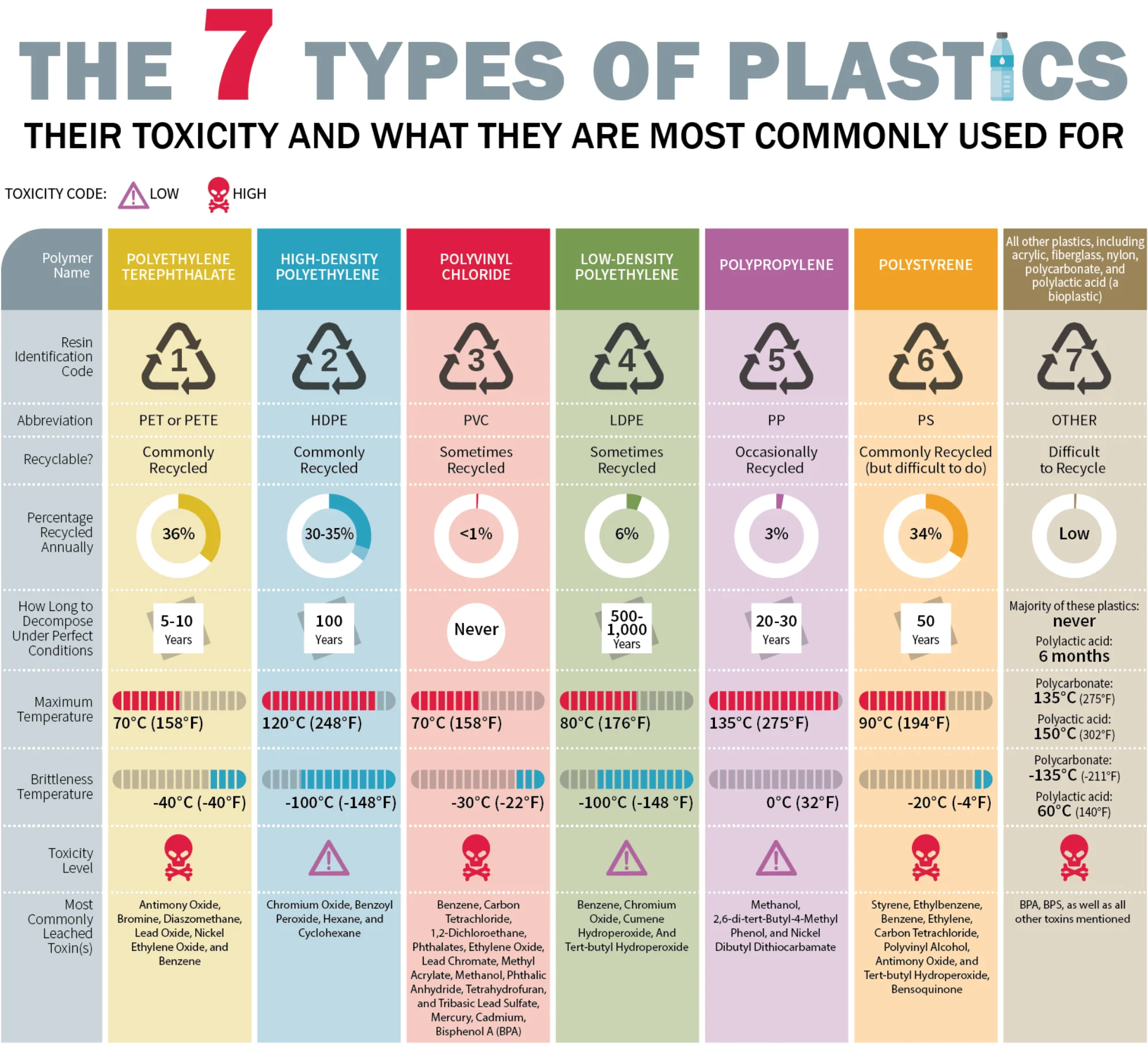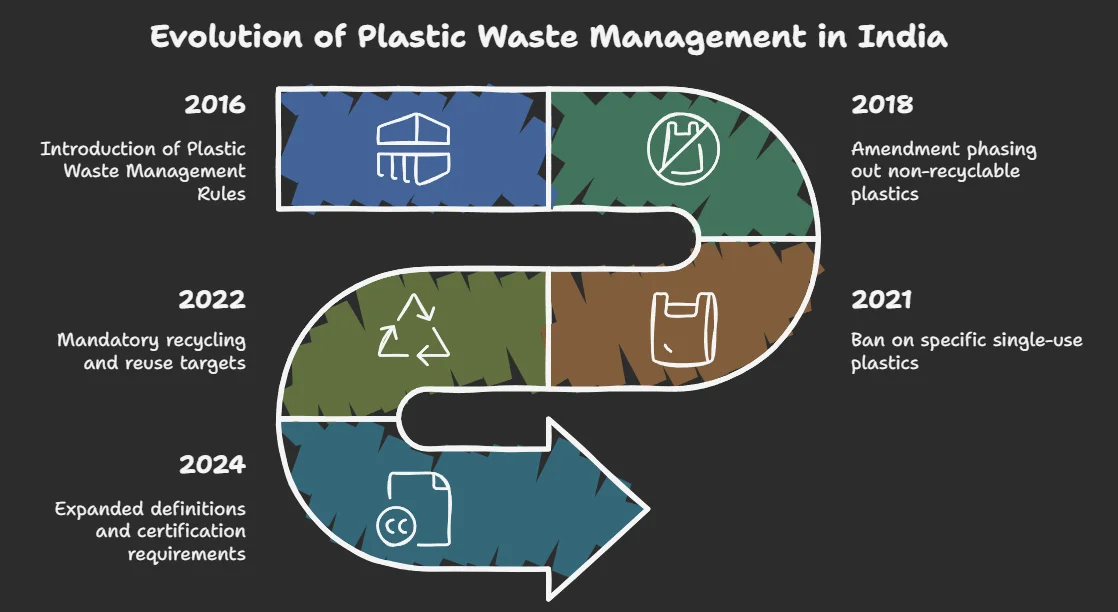Biodiversity & Environment
Plastic Waste a Public Health Threat
- 05 Jul 2025
- 11 min read
For Prelims: Microplastics, Single-Use Plastics, Virgin plastic, Endocrine-disrupting Chemicals
For Mains: Plastic Waste Management, Conservation Environmental Pollution & Degradation Government Policies & Interventions.
Why in News?
Studies have found alarming levels of microplastics and endocrine-disrupting chemicals (EDCs) in human tissues. India, as the world’s top plastic waste generator, faces a growing public health crisis linked to fertility issues, cancers, and chronic diseases.
How are Microplastics and EDC in Plastics Affecting Human Health?
- Microplastics: Microplastics are plastic particles smaller than 5 mm, formed either intentionally (primary) or through the breakdown of larger plastics (secondary).
- Primary microplastics include microbeads in cosmetics and fibres from textiles.
- Secondary microplastics result from the degradation of plastic waste due to sunlight and ocean waves.
- Microplastics are biologically active and have been found in blood, lungs, heart, placenta, breast milk, ovarian follicular fluid, and semen.
- Affect:
- Men: Linked to lower sperm count, motility, abnormal morphology, and hormonal imbalance.
- Women: Associated with poor egg quality, menstrual issues, miscarriage risk, Polycystic Ovary Syndrome (PCOS), and endometriosis.
- Endocrine-disrupting Chemicals: EDCs are natural or human-made chemicals that may mimic, block, or interfere with the body’s hormones, which are part of the endocrine system.
- Plastics often carry EDCs like Bisphenol A (BPA) (in water bottles, food containers), phthalates such as DEHP and DBP (in cosmetics, toys, IV tubes), and PFAS (in food packaging, non-stick cookware).
- Affect: These chemicals mimic or block hormones like estrogen and testosterone, disrupting reproductive health and metabolic functions.
- Plastic additives like DEHP, BPA, and phthalates are classified as probable carcinogens.
- EDCs also contribute to obesity, type 2 diabetes, thyroid disorders, and metabolic syndrome by mimicking cortisol and disrupting insulin response.
What are the Concerns with Plastic Pollution in India?
- Massive and Mismanaged Plastic Waste Generation: India contributes 9.3 million tonnes of plastic pollution annually (burning 5.8 mt and releasing 3.5 mt into the environment) making it the world’s largest polluter, surpassing Nigeria, Indonesia, and China, according to a 2024 Nature study.
- Environmental and Health Hazards: Open burning, a common disposal method, emits toxic pollutants that degrade air quality and harm respiratory health.
- Plastic debris clogs rivers and drains, worsening urban flooding and threatening aquatic biodiversity.
- Single-use plastics persist for centuries, polluting land and oceans and harming marine life. Cities like Mumbai see high microplastic exposure, while phthalate levels in drinking water exceed safe limits in Delhi, Jabalpur, and Chennai.
- Children in polluted areas face increased risks of early puberty, learning issues, and obesity due to EDCs.
- Economic and Agricultural Impact: India could lose USD 133 billion in plastic packaging value by 2030 if waste continues to go uncollected.
- Microplastics in soil from plastic use in agriculture and poor wastewater treatment are degrading soil fertility and threatening food safety.
- The e-commerce boom has escalated plastic packaging waste, most of which is non-recyclable.
- Weak Infrastructure and Regulatory Oversight: Insufficient sanitary landfills, poor segregation at source, and a lack of advanced recycling technology hinder effective waste processing.
- Informal sector recyclers, though critical, operate unregulated, leading to gaps in plastic tracking and environmental safety.
- The enforcement of policies such as the Plastic Waste Management (Amendment) Rules, 2024 and Extended Producer Responsibility (EPR) remains inconsistent and inadequate.
- Rise in Single-Use Plastics (SUPs), which account for 43% of total plastic waste. Despite regulatory bans, enforcement remains poor due to the low cost and easy availability of such plastics.
- Data and Policy Gaps: Official collection rates (95%) are overstated; real rates are closer to 81%, hampering effective planning.
- Global North-South Divide: Despite lower per capita plastic use (0.12 kg/day), India’s poor disposal systems result in more environmental leakage compared to high-income countries with better infrastructure.
India’s Initiatives Related to Plastic Waste Management
How Can India Combat the Growing Threat of Plastics?
- Microplastic Filtration Systems: Invest in advanced water treatment technologies to filter microplastics to reduce plastic contamination in the environment and the food chain.
- The National Plastic Waste Reporting Portal will help track and monitor waste more effectively.
- Behavioural Change and Public Awareness: Launch national campaigns under Swachh Bharat Mission 2.0 and Mission LiFE to educate citizens about plastic hazards and encourage plastic-free lifestyles.
- Integrate environmental education in school curricula and promote reduce-reuse-recycle values from an early age.
- Encourage use of eco-friendly alternatives (glass, cloth, jute, biodegradable polymers).
- Biomonitoring and Public Health Surveillance: Establish national biomonitoring programs to assess the levels of EDCs in blood, urine, and breast milk, and fund longitudinal studies to track health outcomes such as fertility issues, metabolic diseases, and cancer.
- Regular surveillance of plastic pollution and its effects on public health should be implemented to inform policymaking.
- Fiscal Measures and Economic Incentives: Increase eco-taxes or cess on virgin plastic production and packaging to limit production.
- Provide subsidies and tax benefits for industries investing in eco-friendly packaging and plastic alternatives.
- Stronger Regulation and Enforcement: India must move beyond end-of-pipe waste solutions by revising the Plastic Waste Management Rules to address low-dose chemical toxicity (such as EDCs), microplastic contamination, and the heightened vulnerability of children and pregnant women.
- Under the PWM Rules 2024, Producers, Importers, and Brand Owners (PIBOs) are legally obligated to collect and responsibly process the plastic packaging they introduce, including compostable and biodegradable plastics.
- While an online submission and tracking system has been introduced to ensure compliance, its effectiveness depends on robust implementation and strict monitoring.
- Harmful plastic additives should be classified as toxic under the Environment Protection Act, 1986.
Additionally, the EPR mechanism must be strengthened through material-specific targets, third-party audits, and traceability via plastic credits to ensure accountability and circularity.
- Under the PWM Rules 2024, Producers, Importers, and Brand Owners (PIBOs) are legally obligated to collect and responsibly process the plastic packaging they introduce, including compostable and biodegradable plastics.
- Collaborate on Global Plastic Initiatives: India should align with global initiatives like the UN Clean Seas Campaign to share knowledge and best practices for reducing plastic waste globally.
|
Drishti Mains Question: India is now the world’s top plastic polluter. Examine the socio-economic and health impacts of plastics. Suggest reforms to tackle this crisis. |
UPSC Civil Services Examination, Previous Year Questions (PYQs)
Prelims
Q.1 In India, ‘extend producer responsibility’ was introduced as an important feature in which of the following? (2019)
(a) The Bio-medical Waste (Management and Handling) Rules, 1998
(b) The Recycled Plastic (Manufacturing and Usage) Rules, 1999
(c) The e-Waste (Management and Handling) Rules, 2011
(d) The Food Safety and Standard Regulations, 2011
Ans: (c)
Q.2 How is the National Green Tribunal (NGT) different from the Central Pollution Control Board (CPCB)? (2018)
- The NGT has been established by an Act whereas the CPCB has been created by an executive order of the Government.
- The NGT provides environmental justice and helps reduce the burden of litigation in the higher courts whereas the CPCB promotes cleanliness of streams and wells, and aims to improve the quality of air in the country.
Which of the statements given above is/are correct?
(a) 1 only
(b) 2 only
(c) Both 1 and 2
(d) Neither 1 nor 2
Ans: (b)
Q. Why is there a great concern about the ‘microbeads’ that are released into the environment? (2019)
(a) They are considered harmful to marine ecosystems.
(b) They are considered to cause skin cancer in children.
(c) They are small enough to be absorbed by crop plants in irrigated fields.
(d) They are often found to be used as food adulterants.
Ans: (a)
Mains
Q: What are the impediments in disposing the huge quantities of discarded solid waste which are continuously being generated? How do we remove safely the toxic wastes that have been accumulating in our a habitable environment? (2018)








